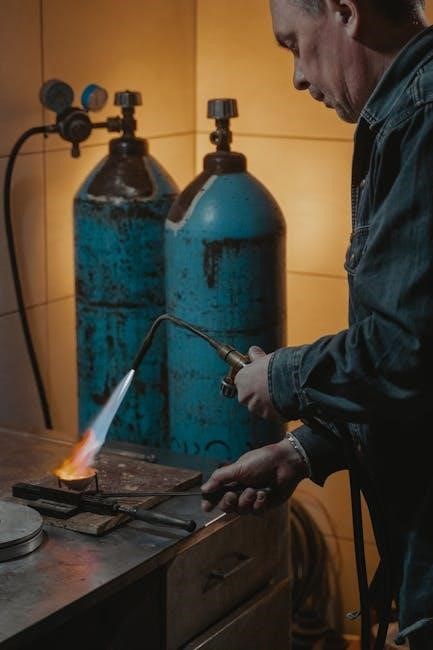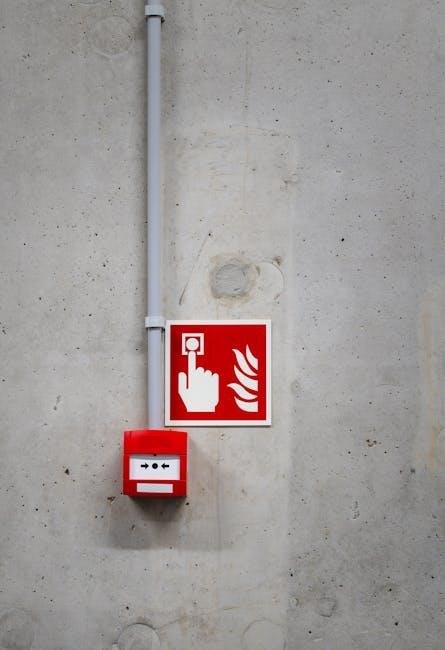Overview of Fire Alarm Systems
Fire alarm systems are designed to detect and warn people of potential fires‚ providing a critical layer of safety and protection. These systems typically consist of a combination of sensors‚ detectors‚ and alarm devices that work together to identify and respond to fire hazards. The overview of fire alarm systems includes understanding the different types of systems available‚ such as smoke detectors‚ heat detectors‚ and carbon monoxide detectors. Additionally‚ it is essential to consider the various components that make up a fire alarm system‚ including control panels‚ notification devices‚ and initiating devices. By understanding how these components work together‚ individuals can better appreciate the importance of fire alarm systems in preventing injuries and property damage. Furthermore‚ a comprehensive overview of fire alarm systems should also include information on system design‚ installation‚ and maintenance‚ as well as troubleshooting and repair procedures. This knowledge can help ensure that fire alarm systems function correctly and provide effective protection in emergency situations. Overall‚ a thorough understanding of fire alarm systems is crucial for ensuring public safety and preventing fires.

Importance of Fire Alarm Manuals
Fire alarm manuals provide crucial guidance on installation‚ operation‚ and maintenance‚ ensuring safety and compliance with regulations always‚ using online resources and documents for easy access purposes.
Understanding Fire Alarm System Components
Understanding fire alarm system components is essential for effective installation and maintenance‚ and manuals provide detailed information on various parts‚ including control panels‚ sensors‚ and notification devices. The control panel is the brain of the system‚ receiving signals from sensors and triggering alarms. Sensors detect smoke‚ heat‚ or other signs of fire‚ and notification devices alert occupants of potential danger. Manuals also cover system wiring‚ power supplies‚ and backup systems. By understanding these components‚ users can ensure their fire alarm system is functioning correctly and providing adequate protection. Online resources and documents are available to provide further guidance and support. Fire alarm system components must be properly installed‚ tested‚ and maintained to ensure reliable operation and compliance with safety regulations. Regular inspections and testing are crucial to identify potential issues and prevent false alarms. Proper understanding of system components is vital for safe and effective operation.

Types of Fire Alarm Systems
Conventional Fire Alarm Systems
Addressable Fire Alarm Systems

Fire Alarm System Installation
Installation requires planning‚ with resources available online‚ including guides and technical specifications for proper setup and configuration always.
Pre-Installation Checks and Planning
Pre-installation checks and planning are crucial steps in the fire alarm system installation process‚ requiring careful consideration of various factors‚ including the type of system to be installed‚ the size and layout of the building‚ and the specific fire safety requirements of the occupancy.
The planning phase involves reviewing the building’s design and layout‚ identifying potential fire hazards‚ and determining the optimal location for fire alarm devices‚ such as smoke detectors and pull stations.
This information is used to create a detailed installation plan‚ which outlines the specific materials and equipment needed‚ as well as the sequence of installation tasks to be performed.
By taking the time to properly plan and prepare for the installation‚ installers can ensure that the fire alarm system is installed correctly and functions as intended‚ providing reliable fire protection for the building and its occupants.
Online resources‚ such as installation guides and technical specifications‚ are available to support the planning and installation process.

Troubleshooting Fire Alarm Systems
Troubleshooting guides and resources are available online to help resolve issues with fire alarm systems quickly and efficiently always using technical specifications.
Common Issues and Solutions
Common issues with fire alarm systems include false alarms‚ faulty sensors‚ and malfunctioning control panels. These issues can be resolved by referring to the fire alarm manual‚ which provides troubleshooting guides and technical specifications. The manual also includes information on how to perform routine maintenance and testing to prevent issues from arising. Additionally‚ online resources are available to provide further guidance and support. These resources include instructional videos‚ user forums‚ and technical bulletins. By utilizing these resources‚ users can quickly and easily resolve common issues and ensure their fire alarm system is functioning properly. Furthermore‚ regular inspection and testing of the system can help identify potential issues before they become major problems. This proactive approach can help prevent false alarms‚ reduce downtime‚ and ensure the overall reliability and effectiveness of the fire alarm system. Proper training and documentation are also essential for troubleshooting and maintenance.
Fire Alarm System Maintenance
Maintenance involves regular inspection and testing of systems‚ with online resources providing guidance and support for proper upkeep and repair always using manuals.
Regular Testing and Inspection
Regular testing and inspection of fire alarm systems are crucial to ensure they function properly in the event of a fire; This involves checking the system’s components‚ such as smoke detectors and alarm panels‚ to identify any potential issues. Online resources‚ including instruction manuals and technical specifications‚ can provide guidance on how to perform these tests and inspections. Additionally‚ many manufacturers offer troubleshooting guides and FAQs to help resolve common problems. By conducting regular testing and inspection‚ individuals can help prevent false alarms and ensure their fire alarm system is working correctly. This is especially important for commercial and residential buildings‚ where a functioning fire alarm system can help save lives and prevent property damage. Furthermore‚ regular testing and inspection can also help identify any needed repairs or replacements‚ allowing individuals to take proactive steps to maintain their fire alarm system. Regular maintenance is essential.
